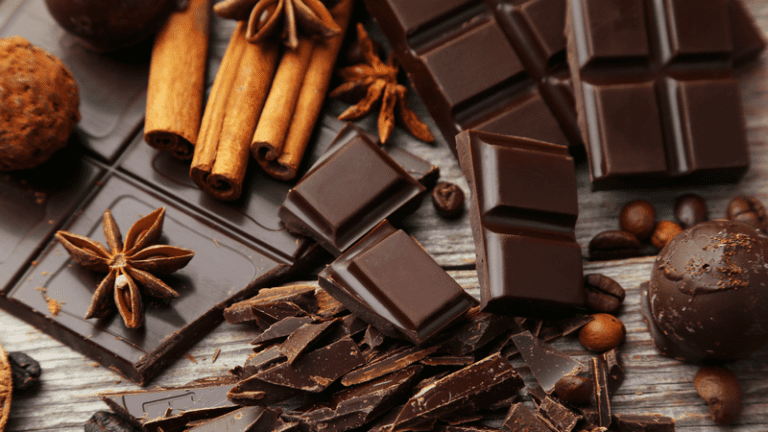The Chocolate Season is here, and I can already feel the tension rising.
“Between Halloween and New Year’s Eve, I feel surrounded by chocolate. It’s everywhere!” reported a self-proclaimed chocoholic. “I try so hard to not eat it, but I inevitably succumb, and I inevitably gain weight. Thank goodness for January First!!!”
If you share the same love-hate relationship with chocolate, keep reading. And be thankful this so-called “bad food” offers benefits.
The Good News
Chocolate is made from cocoa, a plant. It is a rich source of health-protective phyto (plant) nutrients, just like you’d get from fruits, vegetables, and whole grains. Two tablespoons of natural cocoa power (the kind used in baking) offers the same antioxidant power as 3/4 cup of blueberries or 1.5 glasses of red wine.
- Of all the types of chocolate, dark chocolate is the richest source of phytonutrients. Unfortunately, dark chocolate has a slightly bitter taste and most athletes prefer the sweeter milk chocolate (with more sugar and saturated fat).
- One phytonutrient in cocoa is nitrate. Nitrate gets converted into nitric oxide, a compound known to increase blood flow and, in high doses, enhance athletic performance.
- Other types of phytonutrients in cocoa are flavonoids (also found in tea, apples and onions). Epidemiological surveys suggest these flavonoids reduce the risk of heart disease in people who regularly consume chocolate (1).
The Bad News
Athletes, like most people, commonly eat chocolate in bursts—a lot in a day, such as a reward on a Friday afternoon, or indulging on Halloween.
Depriving oneself of daily chocolate easily creates urges to binge-eat when given the chance.
You know the scenario: “Sunday is my ‘cheat day’— my last chance to eat Chocolate Kisses for the week. I stuff ‘em in!” The question arises: Would enjoying two Hershey’s Kisses every day reduce the urge to devour the whole bowl of them at once?
Taking the power away from chocolate
If you like chocolate too much—to the extent you have trouble stopping eating it once you start, an easy way to take the power away from chocolate (and other sweets) is to eat it more often in appropriate portions. Trying to stay away from it will backfire. Think about it this way: Do apples have power over you? No. You give yourself permission to eat an apple whenever you want. So why does chocolate have power over you? Because you try to not eat it.
To take the power away from chocolate, enjoy some every day, such as for dessert after lunch or planned into an afternoon snack. By regularly eating chocolate, it will become a commonplace food, just like eggs, apples, or carrots.
Note to parents: Denial and deprivation leads to overeating in kids, as well as in adults. Letting your kids enjoy—and self-regulate their intake of—(Halloween) candy is the better path than forbidding them to eat it. Do you really want to be the food police?
Living without Cravings for Chocolate
Some athletes believe they are born with a sweet tooth. Not the case. When the body is hungry (and athletes’ bodies can get very hungry), it craves quick energy, sugar. The solution to sugar cravings is to prevent hunger by eating enough quality-calories earlier in the day. Unfortunately, I meet way to many athletes who believe food is fattening or they have no time to eat. They live with a niggling hunger that can easily explode into a chocolate binge. They are not chocoholics; they are just athletes who have gotten way too hungry.
Fortunately, there are ways to manage sugar cravings:
- Prevent hunger by eating more breakfast and lunch.
- Plan sweets into your overall healthful daily food plan.
Chocolate cake for breakfast?
If you would really enjoy eating chocolate as a regular part of your sports diet/weight management program, I suggest you eat chocolate at breakfast. Yes, chocolate cake for breakfast enhances weight loss —at least, according to Daniela Jacubowicz PhD (2). In her research with 193 subjects with obesity (but no diabetes), half ate a 300-calorie protein-based breakfast. The others ate a 600-calorie breakfast that included protein plus dessert, such as chocolate cake.
She instructed both groups to eat the same amount of total calories: 1,400 (for women) and 1,600 (for men). In the first 16 weeks, both groups lost an average of 33 pounds per person. But in the next 16 weeks of the study, the group with the smaller breakfast complied poorly with the diet and regained an average of 22 pounds per person. The dessert-with-breakfast group continued to lose another 15 pounds each. By 32-weeks, they had lost about 40 pounds more than their peers.
Jacubowicz noticed those who had dessert with breakfast had fewer cravings for sweets later in the day for 2 reasons:
- By front-loading their calories with the 600-calorie breakfast, they were less hungry and less likely to stray from the diet.
- When they satisfied their cravings for sweets/treats in the morning, they were less tempted later in the day.
So what does this research mean for you?
- Eat a satisfying breakfast that leaves you feeling content. Do not stop eating breakfast just because you think you should, but rather because you feel satiated.
- If you want a treat, such as chocolate, eat it at breakfast as opposed to overindulging at night. Really, is there a health difference between enjoying dessert after breakfast instead of after dinner?
- Even on a weight reduction diet, you should eat what you truly want to eat, including chocolate, in an appropriate portion.
The Bottom Line
By no means is chocolate the key to a healthy sports diet, nor is eating lots of dark chocolate preferable to snacking on apples and bananas. But we can certainly enjoy chocolate as a small part of a well balanced sports diet. Just make sure it does not crowd-out other nutrient dense foods. As always, moderation is the key.
Sports nutritionist Nancy Clark MS RD CSSD has a private practice in the Boston-area (Newton; 617-795-1875), where she counsels both fitness exercisers and competitive athletes, teaching them how to eat to win. Her popular Sports Nutrition Guidebook, and food guides for marathoners, cyclists and soccer are available at nancyclarkrd.com, as well as information about her online workshop and teaching materials.
———————————————-
CoachUp is the safest and easiest way to find a coach for personalized training. With our 100% money-back guarantee and vetted coaches, anyone can achieve their full athletic potential. Find your perfect coach today and become the athlete you want to be!
References
1.Buijsse B,Feskens EJ, Kok FJ, Kromhout D. Cocoa intake, blood pressure, and cardiovascular mortality: the Zutphen Elderly Study. Arch Intern Med. 27;166(4):411-7, 2006.
2. Jakubowicz D, O Froy, J Wainstein, M Boaz. Meal timing and composition influence ghrelin levels, appetite scores and weight loss maintenance in overweight and obese adults.Steroids77(4): 323-331, 2012.
How useful was this post?
Click on a star to rate it!
Average rating 4 / 5. Vote count: 1
No votes so far! Be the first to rate this post.



